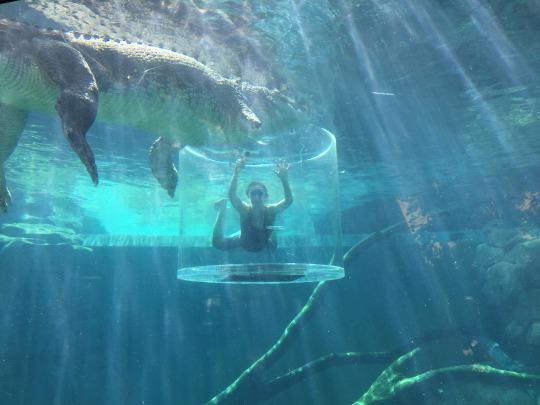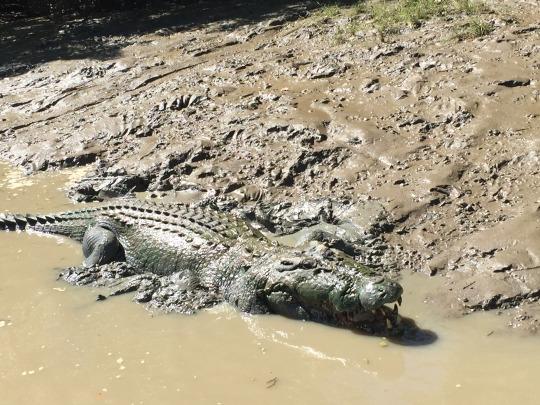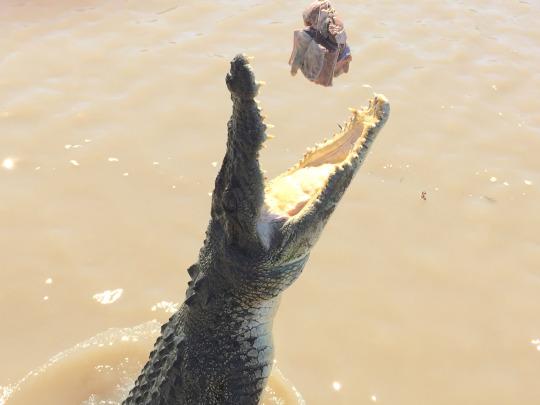There is almost nothing more terrifying yet magical than being out in the Pacific Ocean, off the coast of Hawaii’s Big Island, with 18-foot-wide, alien-looking beings swimming backward loops just millimeters from your face.
One of the most fascinating things to experience in Hawaii is to take a night swim with giant manta rays. Although fierce looking — with triangular fins, horn-shaped cephalic fins, gaping maws, and long, sharp tails — they are not to be confused with some of their fiercer cousins (think sharks or Steve Irwin and his unfortunate demise).
Related: Inside the Cage of Death With Australia’s Monster Crocs
“They are harmless — unless you dangle your feet and they accidentally hit you as they glide by,” Bob, my guide from Jack’s Diving Locker, said. “The largest of them can get up to 23 feet long and weigh 3,600 pounds, so it would be like getting hit by a Mac truck. But don’t worry,” he assured me, “that hasn’t happened — yet.”

A manta ray gracefully swims past a group of divers on a night dive in Kona. (Photo: Getty Images)
For someone who has a healthy respect for (read: fear of) the ocean, this wasn’t as reassuring as when Bob claimed sharks wouldn’t be present.
“Of course, sharks are in the ocean, but they usually stay away from the diving spots,” he said. “They usually feed at different times, and, well, no one’s been attacked on a dive — yet.”
Related: Whip Cracking Sunsets at Mindil Market in Darwin, Australia
Despite all the “yets,” I suited up — there was, after all, a 5-year-old boy on the boat, and I was not going to be outdone by a kindergartner.
The boats leave at sunset and cluster around the Sheraton outside of Kona.
“The night diving and snorkeling started when the Sheraton opened,” our guide said. “The lights from the hotel attracted the plankton, which brought the mantas.”

Divers and surface swimmers coordinate lights to attract the plankton that the manta rays feed on. (Photo: Jack’s Diving Locker/Facebook)
These days there are even more night lights. The divers bring beams of light with them and coordinate with the surface swimmers (that’d be me), clinging onto surfboards specially outfitted with more lights to create a column of light in the black darkness of the night ocean.
Related: Wipeout! Surfing With Famed Chef Eric Ripert in Puerto Rico. Not as Easy as It Looks
And then the giants come. At first there are one or two manta rays, gliding through the illuminated column, and suddenly you’re surrounded by the seemingly hollow beasts who, when they open their mouths, reveal the ocean through their two-foot-long gills.

A group of manta rays feeding at night. When they open their mouths, they seem magically hollow. (Photo: Getty Images)
It’s a silent ballet of creatures not even Cirque du Soleil could have thought up. The surreal experience is like watching aliens glide through the darkness, appearing from nowhere and disappearing, mystically, minutes later.
Afterwards, the snorkelers with me sat silent for a minute before looking around the boat in awe at the black ocean, hiding its marvels.
If you ever find yourself on the Big Island of Hawaii — go. It’s the experience of a lifetime.



